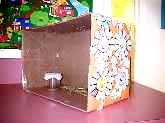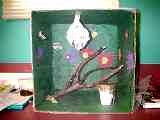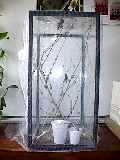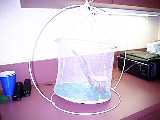| Week 1- Getting started, looking and learning. |
The Task | Resources | The Process | Week 1 | Week 2 | Week 3 | Conclusion
| Week 1- Getting started, looking and learning. |
Day 1-When your caterpillars arrive, read the instruction booklet that is included, very carefully. It will tell you how to care for the caterpillars, what to do once the chrysalides are formed, and all the directions for building your butterfly house.
Activities - 1. Look closely at your caterpillars. What do you see? Begin your daily journal by writing the date you received your caterpillars. Then, write down all the things you see the caterpillars doing. Draw a picture of what the caterpillar looks like. What color are they? Where are their heads? How many legs does they have? Do they have any special markings? Can you predict how long it will take the caterpillars to make their chrysalides?
2. For a closer look, click on Photo of the Painted Lady Butterfly, www.butterflywebsite.com/images/buttrfly/Maier/CarduiO.jpg This is what your butterflies will look like. After you look at the photo, click your back button to return to this page.

Day 2 - 1. Look at your caterpillars closely. In your daily journal, write down the day number and what you see. Did the caterpillars change? If they did, what do they look like now? Did they get bigger? What is that silky stuff in the caterpillar cup? What are those little green balls in the cup? Read your instruction booklet to find your answers and write them in your journal. Draw a picture to describe how your caterpillars look today.
2. A caterpillar sheds its skin 5 times before it becomes a chrysalis. Have your caterpillars shed their skin? Keep a record of this in your journal.
3. Read Charlie the Caterpillar, by Dom De Luise. Your classroom teacher will read this story to the class. If you are learning at home, ask an adult to read it to you or you can read it yourself!
4. Begin building your butterfly house.
Ask a friend or adult to help you. Here are some pictures of butterfly
houses built by the students at Ranchos Elementary School.
 |
 |
 |
 |

Day 3 - 1. Record any changes you see in your caterpillars in your daily journal. Don't forget to write down the day number. Did your caterpillars grow? Have they shed their skin? Is there more of that silky stuff in the cup? In Nature, the caterpillar uses the silk to pull the edges of a leaf together around itself. Why would this be helpful to the caterpillar?
2. Ask your classroom teacher or another adult for a magnifying glass. Look carefully along the sides of the caterpillar. The caterpillar's body is made up of segments (like beads in a necklace). There is a small, dark hole (spiracle) ringed in white on the sides of each segment. What are these for? Do the spiracles help the butterfly smell food, breathe air, see things or blow bubbles? Look up butterflies in the encyclopedia to find the right answer. Click on Photo of the Painted Lady caterpillarwww.butterflywebsite.com/images/caterpil/cat013.gif Study the photo carefully. Do you see the segments and spiracles? After you look at the photo, click your back button to return to this page.
3. In your journal, draw a picture of the caterpillar with its segments and spiracles.

Day 4 - 1. You should have your butterfly house ready.
2. In your journal, write down the changes you see. Don't forget the day number. What are the caterpillars doing now? Are they starting to crawl to the top of the cup? Do you think they have had enough to eat? Are they getting bigger or staying the same size? Can you see their jaws move as they chew?
3. Click on The Life Cycle of the Painted Lady butterfly www.butterflywebsite.com/Articles/ShowArticle.cfm?ID=180 This shows you all four stages of the life cycle. We will only see three stages in our lesson. What stage is missing?
4. Click on Frequently Asked Questions About Butterflies www.butterflywebsite.com/Articles/ShowArticle.cfm?ID=158. Do caterpillars have ears? Do they have teeth? Write the answers in your journal.

Day 5 - 1.Record all the changes that you see with your caterpillars. By now, all of your caterpillars should be crawling to the top of the cup and attaching themselves there. Draw a picture in your journal to describe what you see.
2. Let's not forget the first stage of the butterfly lifecycle- The Egg. Click on The Amazing Life Cycle of the Butterfly www.butterflywebsite.com/Articles/ShowArticle.cfm?ID=61. Answer the following questions. Write your answers in your journal. 1. Where do the female butterflies lay their eggs? 2. Can you see the eggs without a magnifying glass? 3. How long does it take for the eggs to hatch? 4. How do caterpillars fasten their chrysalides or cocoons to a plant?
3. Read From Caterpillar to Butterfly, by Deborah Heiligman. Your classroom teacher will read this story to the class. If you are learning at home, ask an adult to read you the story or you can read it yourself!
Click on the blue words below that say Week 2 to continue.
The Task
| Resources | The
Process | Week 1 | Week
2 | Week 3 | Conclusion